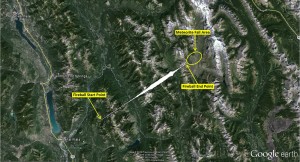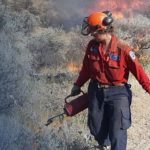Home »

Hunt on for rare rock after meteorites fall
University of Calgary geoscience professor asking for the public’s help
A month after a spectacular fireball December 20, 2014, over the Rocky Mountains, University of Calgary researcher Alan Hildebrand is on a quest for rare meteorites.
In the early morning hours of December 20 a small piece of an asteroid entered Earth’s atmosphere high above Canal Flats, headed northeastwards towards Calgary, Alta.
Although western B.C. and eastern Alberta were overcast, the fireball was seen and imaged over the region between the clouds in both provinces. One spectacular still image was luckily taken by Brett Abernethy who was out with a friend imaging the night sky over Mt. Rundle near Banff when the fireball blazed an 80 km-long trail across the sky (lead image).
“We were looking north when everything lit up and we turned to see the fireball. It broke into at least three pieces and turned bright orange before fading away. After the initial shock I remembered that I was exposing a shot during the fireball and was overjoyed to discover that the shot was not overexposed,” Brett said. He alerted the Calgary Herald to the event, which published his image, stimulating online discussion from other eyewitnesses.

In his search for more information about the fireball Hildebrand contacted Rick Nowell at the College of the Rockies in Cranbrook, who recorded it with his Sandia all-sky video camera through patchy clouds, and was able to correctly mark the fireball’s start time to precisely 00:25:00. With this accurate time, another all-sky still image was obtained from the University of Calgary’s Rothney Astrophysical Observatory (RAO). With these additional images in hand, he and his team were able to triangulate its location in the sky.
“It was very interesting to see how precisely a fireball path could be located just from two pictures taken more than 100 km away. We probably know where it was, start to finish within 100 metres,” says Lincoln Hanton, a recent University of Calgary graduate working with Hildebrand. The video recorded in Cranbrook and the fireball’s trajectory also show that it was a relatively slow entry velocity which favours the fall of meteorites.
Hildebrand says the fireball shows extraordinary properties. “In the photo taken by Brett, the fireball becomes visible at approximately 100 km altitude, starts fragmenting at approximately 60 km, and has its last and biggest explosion at 43 km. Those altitudes are much higher than normal. That means the rock was likely a weak type of asteroid.”
Rare carbonaceous chondrite rock
Hildebrand says the apparent weakness displayed indicates that this rock was unusual, probably a carbonaceous chondrite, which is a specific type of stony meteorite that originates from the Outer Asteroid Belt. At that distance from the Sun, water and carbon-bearing compounds condensed and mixed into asteroidal bodies. Carbonaceous chondrites represent only approximately three per cent of meteorites that fall on Earth.
“Eyewitness accounts indicate that meteorites fell after surviving the trip through the atmosphere; the estimated rock mass entering the atmosphere was about 100 kg, but the largest pieces on the ground are probably only 2 kg,” says Hildebrand. “The meteorites fell in a forested area of the upper White River valley. It’s a tough area to search.” (See Figure 2)
Hildebrand says with the possibility of such a rare find his team will do some searching in the spring and encourages any others who can travel safely in this relatively remote area to search as well.
How you can help
Hildebrand and his team are eager to talk with anyone who saw the fireball from Canal Flats, Fairmont Hot Springs, or Elkford. He encourages property owners in that region to check security camera systems for any shadows cast by the fireball. Anyone who had a wildlife camera in the region is also asked to check that date and time for moving shadows. Contact the University of Calgary at 403-220-8969 or via email at [email protected].
Lead image: Brett Abernethy’s image of the Dec 20 fireball looking south over Mt. Rundle from near Johnson Lake. The fireball crossed the constellation of Orion and then began fragmenting where the trail brightens and broadens. Note the slight reddening at the fireball’s end as the surviving rock fragments slowed and cooled before falling to the ground. Image is a 40 second exposure taken with a Canon 5D Mark III with a wide angle Zeiss 21 mm lens which slightly compresses the vertical aspect of the image. (All rights reserved)
Figure 2: Satellite image of eastern British Columbia showing location of the fireball trajectory projected onto the ground and estimated meteorite fall area as a yellow ellipse. The end of the fireball was about 40 km east of Fairmont Hot Springs. An eyewitness in Canal Flats would have seen the fireball travel almost straight downward in the sky. (Figure constructed on Google Earth base)
Department of Geoscience
University of Calgary







